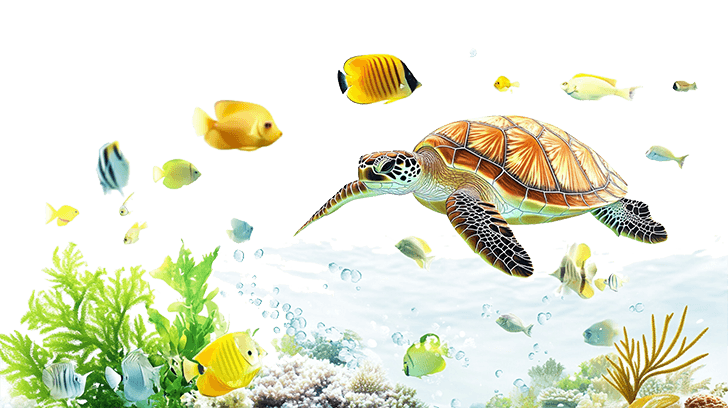Behavior and Interaction: Understanding Your Aquatic Pets
Creating a thriving environment for your aquatic pets begins with understanding their behavior and natural interactions. Each species—whether a calm goldfish, a curious turtle, or an active frog—has unique ways of communicating and expressing its needs. Observing these behaviors not only enhances your experience as a pet owner but also helps you provide an environment that aligns with their natural habits and promotes their well-being. Here’s an in-depth look into the behavior, interaction, and care of various aquatic pets, from fish to turtles, amphibians, and crustaceans.
Fish – Graceful Movements and Signs of Contentment
Fish communicate largely through their movement, color changes, and interaction with their environment. For example, goldfish are generally calm, with slow, graceful movements, and can become surprisingly social with their owners over time. If you observe them swimming confidently around the tank, it’s a sign of comfort and health. Betta fish, on the other hand, display more territorial behavior—especially males. They may flare their gills and fins when they sense another betta nearby, a behavior meant to assert dominance and territory.
Healthy, happy fish often interact with their environment by exploring and occasionally nibbling at plants or decorations. Watch for changes in color—vibrant colors indicate a well-fed and comfortable fish, while dulling can suggest stress or illness.
When interacting with fish, keep in mind their sensitivity to movement outside the tank. Some fish, like guppies or neon tetras, may follow your finger along the glass, which indicates their interest and curiosity. Avoid sudden movements and loud noises near the tank, as these can startle your fish, causing them to dart around or hide. Also, dimming the lights for a few hours a day can help mimic their natural environment, giving them rest and reducing stress.

Turtles – Curious Explorers with Unique Expressions
Aquatic turtles like the red-eared slider have distinct personalities and interact differently than fish. They are curious and tend to explore their habitat actively, moving between water and basking spots. Turtles often learn to recognize their owners and may even swim to the front of the tank when they see you, a behavior that’s both endearing and a sign of social interaction.
Basking is an essential behavior for turtles and is a sign of health. If your turtle spends a good amount of time under the basking light, it’s absorbing essential UV rays for shell and bone health. However, if it’s spending too much time out of the water, this could indicate issues with water quality or temperature, which may need adjustment. (Amazon affiliate link)
Interacting with turtles involves gentle handling, as they can feel stressed by excessive handling or sudden environmental changes. Turtles have strong associations with food, so using feeding as a time for bonding can encourage interaction. They may even respond to your voice or hand movements, though always ensure to wash hands before and after handling to avoid transferring bacteria.

Amphibians – Complex Yet Delicate
Amphibians like frogs and newts have unique behaviors, as they occupy both aquatic and terrestrial environments. For instance, the African dwarf frog spends most of its time in water, occasionally surfacing to breathe. These frogs may appear more active during dawn and dusk, showing natural crepuscular behavior, which means they are most active in low light conditions.
Amphibians are sensitive to both water quality and environmental humidity. They may spend more time in certain parts of the tank if they sense something is amiss in their environment. If you notice a frog lingering near the surface or attempting to escape, it could be a signal that the water quality isn’t ideal or that there’s insufficient oxygen. Frequent water changes and careful monitoring of the water parameters can help mitigate these issues. (Amazon affiliate link)
Interacting with amphibians is generally hands-off; handling can harm their sensitive skin. Instead, observe them at a distance and allow them to explore naturally. Their feeding times, when they come out for food, are ideal for observing their behavior and ensuring they are eating well.

Crustaceans – Natural Scavengers and Ecosystem Cleaners
Crustaceans like shrimp and crabs have vital roles in their habitats, serving as natural cleaners. They are often seen scavenging around the tank, picking at algae and uneaten food, which keeps the tank cleaner and healthier for other inhabitants. Crustaceans may show curiosity by exploring every nook and cranny, sometimes even “grooming” themselves with their claws, a sign of a well-maintained and comfortable environment.
Crabs, in particular, may engage in mild territorial behavior, especially in smaller tanks or crowded conditions. To avoid conflicts, provide plenty of hiding spots and a spacious tank that allows them to explore independently. Crustaceans generally interact less with their owners but are fascinating to watch as they interact with the tank environment. If you observe them moving in and out of hiding or actively scavenging, this typically indicates that they are content.

Understanding Common Behavioral Issues
- Hiding Excessively – If any aquatic pet spends too much time hiding or is less active than usual, this could be a sign of stress. For fish, this can indicate poor water quality, while for turtles, it may mean the basking area is too hot or cold. Test the water quality, adjust temperatures, and ensure there are plenty of hiding spaces for them to retreat to when needed.
- Refusal to Eat – This could be due to stress, illness, or changes in the environment. Fish and turtles may refuse food if the water temperature is incorrect or if they’re adjusting to new tank mates. Amphibians and crustaceans might avoid food if water conditions are not ideal. Ensure feeding times are consistent and avoid overfeeding, as this can pollute the tank.
- Aggressive Behavior – This is common in territorial species like bettas and crabs. For fish, ensure they have plenty of space and hiding spots. Consider separating territorial species or providing larger tanks to reduce aggression.
- Gasping at the Surface – This is often a sign of low oxygen levels in the water. Fish and amphibians may exhibit this behavior if the tank is overstocked, poorly filtered, or if there isn’t enough surface agitation. Regular water changes and a well-maintained filter system can help keep oxygen levels balanced.

Curious Facts About Aquatic Pet Behavior
- Fish Sleep – Fish do sleep, but they don’t have eyelids, so they don’t close their eyes. Most fish slow down and hover in a safe spot in the tank when resting.
- Turtle Memory – Turtles are surprisingly intelligent and have strong long-term memories. They can remember their owners and show signs of recognition.
- Amphibian Metamorphosis – Many amphibians go through metamorphosis, changing from water-breathing larvae to air-breathing adults. This fascinating transformation often happens over just a few weeks.
- Shrimp Molting – Shrimp regularly molt, shedding their exoskeletons as they grow. During this time, they may hide more often to protect their soft, vulnerable bodies until the new exoskeleton hardens.
By observing and understanding these unique behaviors, you’ll become attuned to your aquatic pets’ needs and provide a healthier, more harmonious environment for them. Each species brings its own charm and interaction style, making them delightful to observe and care for. Dive deeper into each pet’s world, and enjoy the journey of enhancing their quality of life as they enrich yours.
Affiliate Disclosure
This post may contain affiliate links, which means I earn from purchases made through links. Please see the privacy policy page for more details.







